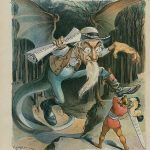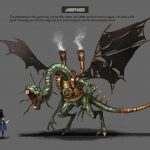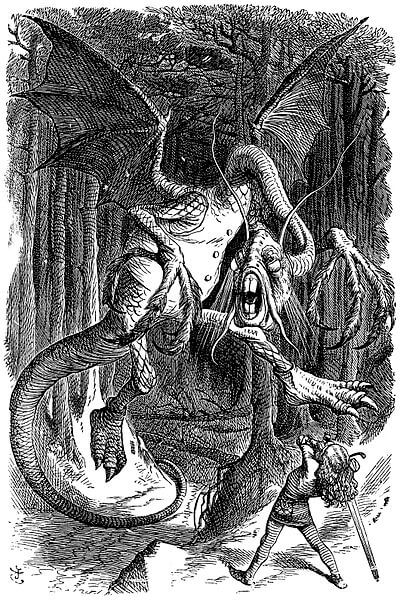This is part of a four-part series. Throughout the series, Jaz will explore the classic Lewis Carroll poem in history and pop culture. Come back each Thursday for a new part.
Beware the Jabberwock: Part 1
- Genesis of the Jabberwock

- A Century (and a half) of Jabberwocks

- The Jabberwock in Literature

- The Jabberwock In Games

Jabberwocky. “Meaningless speech or writing.”
Merriam-Webster
That’s how much the poem, which appeared in Lewis Carroll’s 1872 book Through the Looking Glass, and What Alice Found There, spoke to the collective imagination. By 1902, the poem’s title had found its way into the English language.
The poem can be classified as a nonsense poem. Many of the words Carroll used did not exist before he penned them, and many of them faded to nothing more than fond memories of a much-loved childrens’ story. But, to Carroll’s credit, some others found their way into the dictionary alongside the titular jabberwocky. The verb to chortle has got to be my personal favourite, though I have yet to master the art of chortling myself.
But I digress. We were discussing a poem, weren’t we?
A nonsense poem. An epic, nonsense poem, in fact. You see, if you take the time to look past the wide selection of highly creative words, you find a tale that follows the tradition of epics such as Beowulf or The Hobbit, in which an unlikely hero, against all odds, defeats a monster.
But let’s have another look at the creativity with which the poem itself is crafted. It employs the quatrain structure often used in epic poems, and Carroll brings the opening stanza back to close off the poem, to symbolically bring the hero home once more. We see this pattern of returning in the archetypal hero’s journey. And he did all of it in a perfect ABAB scheme, and iambic meter. I’m not envious of that skill level at all. Nope. Not me. I could sleep to the rhythm of that poem every night.
In the story, Alice comes across the poem on her journey through the mirrorworld, but she can’t seem to make sense of it, until she realises that everything in the mirrorworld should be seen through a mirror. When she looks at a reflection of the poem, she’s able to read it. Apparently, Carroll wanted to have it printed in its mirrored version, but when he passed the request on to his publisher, Macmillan, they supposedly warned against the cost of this. This may have dissuaded him, or they might have had other reasons but the fact is that the only reference left, is the description of how Alice reads the poem’s reflection.
In 1871, John Tenniel agreed to illustrate the book.

A fascination with paleontology and geology were characteristic for the time, so it stands to reason that he’d give the monster a pronounced saurian aspect, with pterodactyl wings and an elongated neck. It is his illustration which has inspired new iterations of the Jabberwock for almost a century and a half, and continues to define the Jabberwock in our collective memory. And yes. The poem is titled Jabberwocky, and many use that same name to refer to the dragon as well, but its name really is The Jabberwock.
Next week we’ll dive into the Jabberwock’s appearances in other literary works, but for now, I bid you goodnight to the dulcet tones of Benedict Cumberbatch’s reading of the poem.
I’m not purring, you are.
Later mythsters!

Jasmine Arch
Jaz, also known as the Wolf Mother, is a writer, poet, narrator, and vessel of chaos. She is eternally grateful for her mother’s refusal to curtail her children in their choices–whether that was literature, spirituality, studies, or appearance–and grew up devouring her older brother’s collection of fantasy novels. In hindsight, telling stories of her own seems inevitable, but it took her a while to accept this and find the courage to begin.
Sources:
https://interestingliterature.com/2016/01/a-short-analysis-of-jabberwocky-by-lewis-carroll/
https://en.wikipedia.org/wiki/Jabberwocky

[…] Blog Posts: Part 1, Part 2, Part 3, Part […]